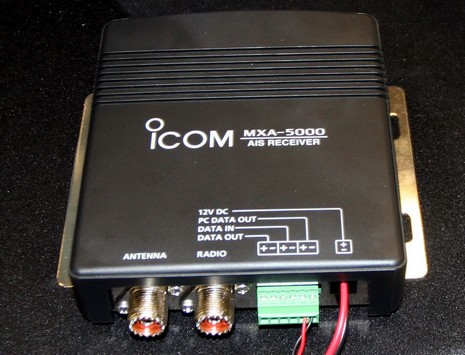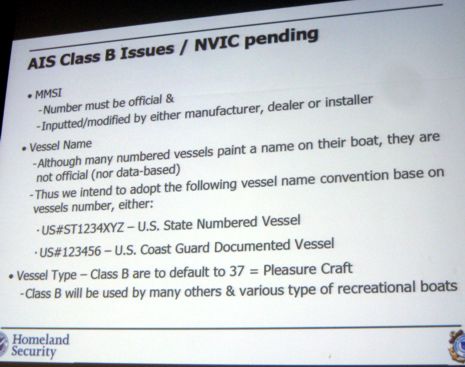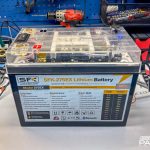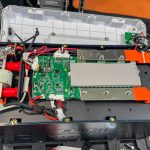Icom AIS receiver, and more on Class B

What with Class B AIS transponders finally coming to market, a new AIS receiver may seem irrelevant. But it’s from Icom, it seems to be designed and priced right, and I suspect that it will be a winner. The $500 MXA-5000 is a true dual channel receiver—especially important when Class B proliferates—with a built-in antenna splitter, dual outputs (plotter and PC), and the ability to mix GPS input into the AIS target stream. This sample unit had just arrived from Japan but the Icom rep here at the NMEA conference said that it seemed to be very sensitive in initial testing. While Class B transponders are also true dual channel receivers, they will cost significantly more, especially when a separate antenna is figured in. The MXA-5000 will be available in December, and maybe so will Class B…
Yesterday afternoon the Coast Guard’s Jorge Arroyo and the FCC’s Ghassan Khalek led a special meeting that was mostly about Class B. It was packed and sometimes raucous. My impressions:
* Manufacturers looking for clear guidelines about how to implement the FCC’s demand that MMSI data be input by vendors, dealers, or installers—not users—did not get them. The USCG and FCC feel that there are multiple ways to fulfill the requirement and are asking manufacturers to submit plans for approval. It sounds like it could be some sort of paper trail guaranteeing that the end installer inputs the data or an online scheme that accomplishes the same goal.
* Technical installers hoping that some sort of certification will be required to install Class B were disappointed. The FCC is concerned about data input, not installation, and its vague language about qualifications is purposeful. There’s a good opportunity here for installers, I think, but the FCC wants the market place to be competitive.
* The really new, and surprising, info about Class B is illustrated in the slide below. The USCG has decided that B transponders should not transmit boat names, as in many cases they are not official or data-based. Instead of a name, that field will be filled with “US#” and the boat’s state registration or federal documentation number. This idea wasn’t discussed much in the meeting, but later on a number of people were grumbling about it. A lot of AIS users really appreciate the ability to hail other vessels by name, or just see who else it out there. I can see how the scheme is more orderly, and will distinguish Class A and B transponders well. But will it reduce the usefulness of AIS, or will we adapt to it? What do you think? {Don’t miss this update.}
Arroyo and Khalek seem confident that Class B transponders will be on the market soon, but there also seem to be lots of details yet to work out. At least now Icom has attached its brand name to this whole safety technology. No doubt there will be lots more talk about AIS here and elsewhere in the coming months.














What, no NMEA 2000?
Seems like a nice unit, I eagerly await the test results and a transceiver variant.
As for the USCG not wanting names on the AIS stream, I find them completely out of touch with how AIS is used in the real world.
AIS B via the FCC is like two elephants making love. It occurred at high levels, with a lot of screaming and moaning, it took two years for anything to come out, and when it did it was a little weaker and stupider than the original, but what the hell, we can get to like it. We think we’ll keep it, warts and all. I’m just glad I don’t have to pay someone $85 to type in some numbers.
ICOM’s receiver adds a certain legitimacy or old school endorsement to the idea, and its certainly a reasonable price. Missing are some of the as-yet-only-a-dream features discussed here, but Icom hasn’t ever lived on the bleeding edge. I’ll bet it will be Uniden that integrates Y2K, shared DSC phonebooks and push-to-dial calling.
Names in the data stream is an OBVIOUS item. They are really out of touch on this one.
For example, the accepted method of hailing a boat on 16 is as follows, “Osprey, Osprey, Osprey … this is Safari, over..”.
Hailing the boat about to collide with us by name is an obvious safety feature.
Agree entirely with Phil, why do the USCG and FCC insist on meddling with a perfectly good (and internationally agreed) Class B specification?
Boats have names, and calling up a vessel by it’s name (provided by AIS on your plotter) seems obvious? Of course everyone remembers a vessel number…….?
Thanks for letting us know about this, Ben. I’ve certainly got an opinion about this, and rather than write a long essay here in comments, I’ve put it up over at Navagear.
Its called the Happy to Glad Syndrome. Everyone in the chain of governmental processes must contribute something, even if its just changing every “happy” to “glad”, if for no other reason than to prove they were in the office than day, or to claim they made a valuable contribution.
On a good day, I *might* remember the number on my license plates, but I absolutely will not recognize someone calling US#blahblah… I have never even checked to see if its still right on my papers!
Although the MMSI number has to be input by the manufacturer, dealer, or installer, I don’t see this requirement for the boat name.
What would stop me from putting in:
US#1141291/aCappella/Castine,ME
It is beyond ridiculous that the name of a pleasure vessel couldn’t be accessed by others through AIS-B.
The FCC used to have lots of rules about CB licensing, too. All it takes is a success disaster, possibly coupled with a real disaster coming from the AIS not showing vessel names. And once it gets used for perimeter control, the vessel names *will* appear in the messages. Otherwise, the little orange RIBs won’t know who to shoot at.
either that or we’ll have to put the documentation number on the stern, too.
Every message already has the MMSI, which should be in their government database. Why do they care what the name field contains?
Sounds like the MDA (Marine Domain Awareness) guys are getting their fingers into the pie a little too deep. From their perspective AIS is about monitoring boats and ‘port security’ instead of about users interacting with other users.
Icom is just coming to market with a receiver? And it’s 183 based with no N2K? Accompanied by their reluctant and grumpy support, it’s very much too little, too late.
The CG does a lot of good work but their track record on AIS B has been awful.
Boats have names and that is how PEOPLE prefer to refer to them. Hailing “Documented Vessel number 45689321”, or “New York registered vessel NY4321258” just doesn’t seem very customer friendly. I think the CG has lost sight of the fact that taxpayers are their customers, not some annoyance. We are the reason the CG exists.
The information will also list the MMSI, which is a number that the FCC/CG controls, so why can’t the name and numbers co-exist?
The CG doesn’t require the document number to be displayed on the exterior of a vessel, but they do require the boat’s name and hailing port. So what’s with now emphasizing numbers? If the CG goes looking for a particular boat, they’re going to know they’re getting close when they find a boat with the same name. If they go looking for a document number, they won’t find it. If they want to trace a particular bad actor, they have a bona-fide MMSI and they have a database that links the MMSI to an boat and owner. So what’s wrong with including boat name?
It’s a global market. Buy your AIS in Canada, Mexico, The Bahamas, Bermuda, etc. Enter your MMSI and boat NAME. The CG will never have the resources to police every AIS unit in the US.
And how do they intend to handle the sale of a boat, or the sale of an AIS unit? Send it back to the manufacturer to be reprogrammed?
Really intersted in seeing a Class B NEMA 2000 unit…
USCG seems to be missing the safety factor of class B. If you need to contact another vessel in an emergency.. the last thing you want is to rely upon them hearing their call sign!
A skipper is much more apt to hear his vessel’s name. After awhile, all the call signs start sounding the same.
“Did he is OR243ABC or OR234ABT? Whoops.. too late.”
No boat names … they are ruining a perfectly good safety device, I was so much looking forward to being able to hail someone in the fog by boat name.
I would expect the idea of using registration numbers could be dead before next week if there is enough noise.
Who do we write to Ben ?
Tim makes a good point on his site that the power point slide appears to indicate the idea of not using boat names originates from the mind of a database architect.
I agree!
Ben, can you arrange to get the brain trust, data architects and all, responsible for the idiot idea of not using boat names … out onto any of our boats. I for one would like to take them into the fog, explain how radar works, and start hailing people around us by lat/long, course and speed and distance from a bouy, etc. … and maybe they will jump to the conclusion that a boat name would be useful if only we could get that somehow.
These comments are VERY MUCH APPRECIATED. I was hoping for some informed feedback on this boat name issue (while trying not to prejudice it). You all have delivered, and I thank you.
Now I’ll try to make sure that the Coast Guard and other interested parties know how you feel. And if there’s a chance of changing or modifying the naming plan (Jeff, your idea won’t work as the FCC includes Vessel Name in the static data that must be input by vendor or installer).
Don’t miss Tim Flanagan’s blog entry on this:
http://www.navagear.com/2008/10/class-b-ais-no-boat-names/
Dear Ben,
We really appreciate your Blog. It is very informative, and useful.
We introduced the Trueheading Class-B to the Dutch market.
We feel sending the name and call-sign is essential.
We already have many complaints about the fact that older Class-A units cannot read the sentence 24 in which the ships name and call sign is transmitted. Only the MMSI is not enough for save navigation. As everyone is stating here: A vessel is hailed by its name on CH16, not by his number.
As the MMSI is strictly unique for a boat, it is matched in a database to the boats name.
Programming the AIS by a trained and responsible dealer is important. Since the Automatic Identification Code (ATIS), which is mandatory to be programmed in every inland VHF in Europe inland waterways, can be user programmed, quite a lot of VHFs are falsely programmed or not programmed at all. You can imagine that this will also happen to user-programmable AIS-Class B and of course this will not add to safe navigation.
I hope this entry will help you communicating the general feeling about this to the USCG and FCC.
Keep up the good work!
Is it time to start writing letters again? Who do we pester this time? Is it Okay to call someone’s idea stupid and dangerous, or should I stick to bureaucronics? “In the light of new research another consideration was revealed….”
Who should we write?
On the other hand, the MMSI, boardcast with every AIS message, allows you to call the vessel directly on a working channel, and have their radio ring like a telephone. I can see how someone might argue that the boat name is not needed.
However the user interface on existing radios does not make this at all practical. I would not want to be thumbing the manual while keying in a 10-digit number when I am two minutes from a collision!
Richard … that ringing feature can be problematic if
a) My VHF and my AIS have different MMSI numbers.
b) My VHF is broke, and I am using a backup
c) In fog with multiple boats to negotiate with, it could be problematic that multiple boats choose to “ring” me to different working channels.
VESSEL NAME PROPOSAL
If they want to tamper with the original intent of the VESSEL NAME field on AIS, how about leave the option for the current channel of a vessels primary VHF to be appended by the AIS transmitter automatically. Then someone would know I am listening to 9, 16, 69, 72, etc ! E.g. My vessel name would appear as “Breeze Pleeze on 9” while my vhf is on and transmitting the channel via NMEA/N2K.
Not just for my convience … but for homeland security and USCG to quickly determine what boat near a troubled boater has their vhf turned on (apparently not as many as there should be !), and allow them to quickly get a hold of the captain even if their VHF MMSI is different than their AIS MMSI.
Just rolled in from San Diego (red eyed) to find a good news email. Apparently the registration-number-as-Vessel-Name idea was more tentative that I gathered at the meeting. And moreover the USCG has discovered that regular vessel names are in fact captured in the MMSI databases. Therefore it is “likely” that only unamed vessels will be required to use registration numbers in the name slot.
I’m sorry if I issued a false alarm, but it may be that these comments will make a ruling favoring the use of real boat names somewhat more “likely.” I’ll have more on the whole subject soon.
We are reacting to the SLIDE, Ben. And it was pretty clear what its intent was.
But if wiser counsel prevails, the system works, and you are part of it.
If someone got their nose tweeked, I’m sorry…
[that I wasn’t there!]
Commandant, if you read this, thank you and belay my last.
Damn it! Let me amend my “good news” comment above. Apparently “unnamed vessels” will include all that do not have either USCG Documentation or an FCC Station License.
That means anyone with a state registered boat and an MMSI received from BoatUS, Sea Tow, Shine Micro, etc. would have to use the state registration for Vessel Name. I think. I’m embarrassed about all this confusion; I think I’ll unpack, spend some time the love of my life, get some sleep, and try not to think about Class B until tomorrow.
Well, I think using the same MMSI as used for voice communications was one of the fundamental design criteria for the AIS system! It seems to me there is a lot of scope for improving DSC, integrated with AIS. If this is going to work it is important that the MMSIs are the same. I thought the whole point of wanting to control the entry of MMSI is to avoid unnecessary proliferation and ensure it matches the radio.
Dan, I am sure you keep a good radio watch, but I am afraid I do not. I race a sailboat, and I find any background chit chat is very distracting. However, I have heard a few DSC maydays, and when the radio blares like that, it does get my attention!
Richard, I have yet to hear a DSC mayday, but I would think in a potential crossing situation that is not yet an emergency in the fog, someone would not invoke that function. Also, as you pointed out, most people wouldn’t know how to. Rather they need to start guessing what channel to hail someone on… my proposed AIS enhancement would do exactly that, reveal what channel I am on. (although AIS wouldn’t transmit this often, what channel I was on a couple of minutes ago is an excellent predictor of what channel I am on now)
I have to admit my good watch keeping has limits. I keep a good watch … until I am distracted. I will leave the dock on 16, but often be on another channel when I return. I very often forget to switch back to 16 after being on another working channel. For example after racing Saturday I was on 72 when returning to the dock, the channel we listen on for the committee boat.
In the fog I will keep a handheld on 16, as I jump between other channels with my main vhf, but often won’t here other boats a mile out due to the automatic squelch being so instense.
In the fog off of Block Island in July (I was within miles of the collision between the Ferry Boat and the USCG ship), people were on 16 asking other boats to meet them on 9, the Navy was asking people to go to yet another channel to learn about them, a group of boats traveling together were on 69. It seems valuable to me, to have the channel the boat is listening too at my fingertips as well as it’s vessel name. Then I know are they on 9, 13, 16, 69, 72, etc. and if I go to that channel people can find me there also. More likely … if everyone could see everyone else’s working channel, everyone in the same area would gravitate to the same working channel or 9. In addition, with this feature boats traveling together, need not standardize on 69 or something else to communicate, they could all listen on 16 and only change to 69 when they want to talk without learning how to dial up an MMSI number.
I should say … all the recreational craft will gravitate to the same channel. As for the ferry’s, etc. I would imagine we would all just stay clear of them rather then negotiate crossings.
I like Jeffrey’s compromise (if it’s necessary):
Vessel Name: US#1141291/ACAPPELLA
or ACAPPELLA US#1141291.
Dan is making a good case for DSC — Digital Selective Calling — use with AIS.
The MXA-5000 got released. It isn’t NMEA 2000 but at $500 with a built-in splitter, it is a great price.
What I don’t understand is its GPS setup. Correct me if I’m wrong, but AIS transponder relies on GPS for slot synchronization (as well as lat/lon). Every transponder uses GPS time to sync the start time of slot. It doesn’t appear that the MXA has an onboard GPS receiver, which adds a couple hundred dollars.
Does anyone know if the realtime accuracy of a GPS timestamp on the NMEA 2000 bus is good enough?
Anyways, interesting but puzzling. Strange that it doesn’t have an onboard GPS receiver when my cell phone has one.
I am completely confused by this unit. The product literature suffers from bad translation but still I just don’t get the architecture.
It is a *receiver* but then what is the point of hooking up the GPS to it? I guess so that the chartplotter only needs a single serial line. I admit from the bad writing I thought it was a transponder.
Anyways, good to see that it has a built in splitter. This will get other manufacturers to follow suit in that regard. But I will still hold out for an N2K class B transponder with a builtin splitter and builtin GPS. The NAIS-300-L is almost there.
Unfortunately, there is a flaw in the design of the ICOM MXA-5000 which makes installation diffcult in many marine navigation systems.
An example is my Raymarine equipment. Currently, the chartplotter, (an E80) has a stream of NMEA0183 data coming into it. This includes not just the GPS, but also the depth sounder, wind meter, speedometer, vhf radio, and heading sensor. Suppose I buy a Raymarine AIS250 AIS receiver. Then I configure the chartplotter’s NMEA0183 input as a 38.4KBaud AIS input instead, and then connect the AIS receiver data output to this input. I then connect the 4800Baud NMEA0183 data cable — that was connected to the chartplotter — to the data in port on the AIS receiver. The AIS receiver mulitplexes its AIS data together with the data coming in on its data input and sends that to the chartplotter. So now the chartplotter has all of the data, including the new AIS data.
The ICOM MXA-5000 looks like it was designed to do the same thing. It has the 38.4KBaud output, the NMEA 4800Baud input, and the multiplexer. BUT . . . the MXA-5000 strips out all NMEA0183 data except GPS data. So now the chartplotter will not have any of the rest of the data — no speed, no heading, no wind, no depth — and all the functions which need this data will not work, including radar overlay on charts, true wind, boat speed, and depth alarms
Fortunately, I found out about this before installing the receiver. It’s in an unopened box and goes back tomorrow.
Fixing this would require only firmware.